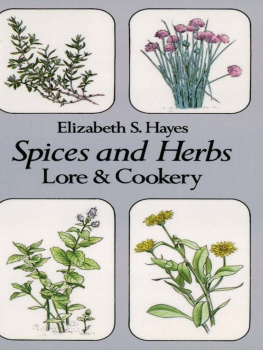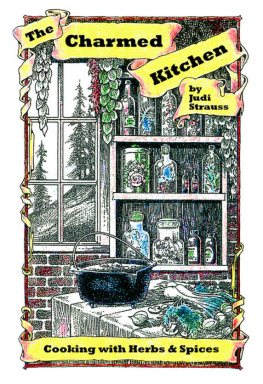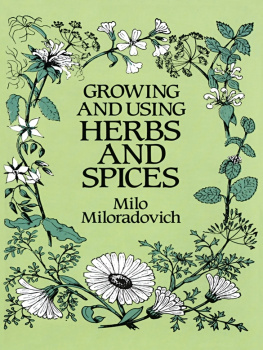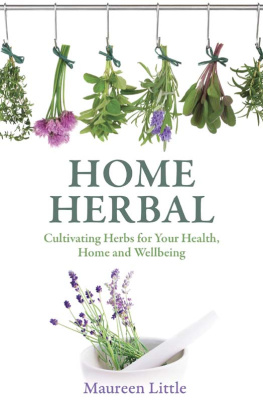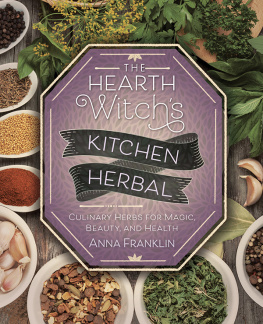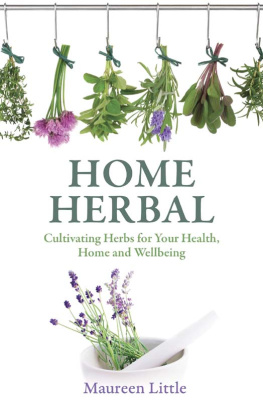HERBAL DELIGHTS
Tisanes, Syrups, Confections Electuaries, Robs, Juleps, Vinegars, and Conserves
by
MRS. C. F. LEYEL
with drawings by
M. E. Rivers-Moore

Copyright 2013 Read Books Ltd.
This book is copyright and may not be reproduced or copied in any way without the express permission of the publisher in writing
British Library Cataloguing-in-Publication Data
A catalogue record for this book is available from the British Library
A Short History of Herbalism
Herbalism (herbology or herbal medicine) is the use of plants for medicinal purposes, and the study of such use. It covers all sorts of medicinal plants, natural remedies or cures, traditional and alternative medicines. Modern medicine tends to categorise herbalism firmly as an alternative therapy as its practice is not strictly based on evidence gathered using the scientific method. Modern medicine does make use of many plant-derived compounds however, as the basis for evidence-tested pharmaceutical drugs. Phytotherapy also works to apply modern standards of effectiveness testing to medicines derived from natural sources.
Medicinal plants have been identified and used throughout human history. Archaeological evidence indicates that the use of medicinal plants dates at least to the Paleolithic age, approximately 60,000 years ago. Written evidence of herbal remedies dates back over 5,000 years to the Sumeranians, who created long lists of useful plants. A number of ancient cultures wrote on plants and their medical uses. In ancient Egypt, herbs are mentioned in Egyptian medical papyri, depicted in tomb illustrations, or on rare occasions found in medical jars containing trace amounts of herbs. The earliest known Greek herbals were those of Diocles of Carystus, written during the third century BC, and one by Krateuas from the first century BC. Only a few fragments of these works have survived intact, but from what remains scholars have noted that there is a large amount of overlap with the Egyptian herbals.
Seeds likely used for herbalism have been found in archaeological sites of Bronze Age China dating from the Shang Dynasty, and herbs were also common in the medicine of ancient India, where the principal treatment for diseases was diet. De Materia Medica (an encyclopaedia and pharmacopoeia of herbs and medicines), written between 50 and 70 AD by a Roman physician, Pedanius Dioscorides, is a particularly important example of such writings; focused on the diet and natural remedies. The documentation of herbs and their uses was a central part of both Western and Eastern medical scholarship through to the eighteenth century, and these works played an important role in the development of the science of botany too. Dandelion for instance, was used as an effective laxative and diuretic, and as a treatment for bile or liver problems, whilst the essential oil of common thyme was (and is) utilised as a powerful antiseptic and antifungal. Before the advent of modern antibiotics, oil of thyme was additionally used to medicate bandages.
The fifteenth, sixteenth and seventeenth centuries were the great ages of herbal remedies; with many corresponding texts being published. The first Herbal to be published in English was the anonymous Grete Herball of 1526. The two best-known herbals in English were The Herball or General History of Plants (1597) by John Gerard and The English Physician Enlarged (1653) by Nicholas Culpeper. Culpepers blend of traditional medicine with astrology, magic and folklore was ridiculed by the physicians of his day, yet his book - like Gerards and other herbals, enjoyed phenomenal popularity. Natural medicines gradually waned in popularity as the 1900s progressed however, and the twentieth century also saw the slow erosion of plants as the pre-eminent sources of therapeutic effects.
Despite this, today the World Health Organization (WHO) estimates that eighty percent of the population of some Asian and African countries use herbal medicine for some aspect of primary health care. Pharmaceuticals are prohibitively expensive for most of the worlds inhabitants, half of which lives on less than two American dollars a day. In comparison, herbal medicines can be grown from seed or gathered from nature at little or no cost. In actual fact, many of the pharmaceuticals currently available to physicians have a long history of use as herbal remedies, including opium, aspirin, digitalis and quinine. As is evident from this incredibly short history of herbalism and natural plant remedies it is an aspect of human medicine with an incredibly long, varied and intriguing record. With many such traditional cures still used in the present; the multifaceted uses of plants continues to surprise us. We hope the reader enjoys this book.
ILLUSTRATIONS
CONTENTS
NOTE
The herbs that are traditionally used medicinally fall more or less into two groups; those that are pleasant to the taste and are used either for culinary purposes or for brewing, distilling, flavouring or for making tisanes, and those that are used for their more definitely medicinal properties.
In this book I have included only those herbs that belong to the first class. In a future volume I propose to treat as fully those herbs that come into the second category. I shall not include any of the poisonous herbs, as that knowledge is too dangerous to be disseminated in a book intended for the general public.
H. L.
INTRODUCTION
Vegetation is the primary source of food for every form of life.
If the earth were not covered with its green growth it would be uninhabitable because the violence of the elements would reduce its surface to powder. Without the shade of trees, shrubs and herbs, the earth would be a desert. The moisture absorbed by plant life is given out again and keeps the surface of the earth from getting parched.
Plants bind the soil together and prevent tempests and floods from washing it away, as grasses bind the sand dunes on the seashore.
All living things from the highest to the lowest can be entirely maintained by this vegetation which appeared on the earth just before the creation of man. Vegetable life before that was strange and flowerless.
The vegetable world is mans natural food and mans natural medicine. It is the link between the animal and mineral kingdoms, as it absorbs mineral products and makes them easy for man to assimilate.
Even more important is the peculiar property of green plants to absorb carbon dioxide from the air by means of their green colouring matter, chlorophyll; in the light of the sun they not only breathe in carbon dioxide and give out oxygen, which is the precise opposite to the process of respiration by animals, but they combine carbon with oxygen and hydrogen and build them into carbohydrates, i.e. the various forms of sugars and starches that make food.
In fact it is the production of organic material from the air by green plants that makes animal life in this world possible, for animals possess no such powers.
All the tissue salts and all the component parts of the blood are contained in a higher and lesser degree in vegetablesin the vegetable life of the earth and the sea.
Every vegetable that grows in the sea contains iodine, every plant that grows on the earth contains potassium, and the pulses contain phosphorus. Roots and seeds are storehouses of energy for new life.
In the case of annuals the most virtue resides in the seeds, in perennial plants, in the roots. With knowledge of the constituents of herbs it is possible to correct and supply the surpluses and deficiencies which cause illness in mankind.


